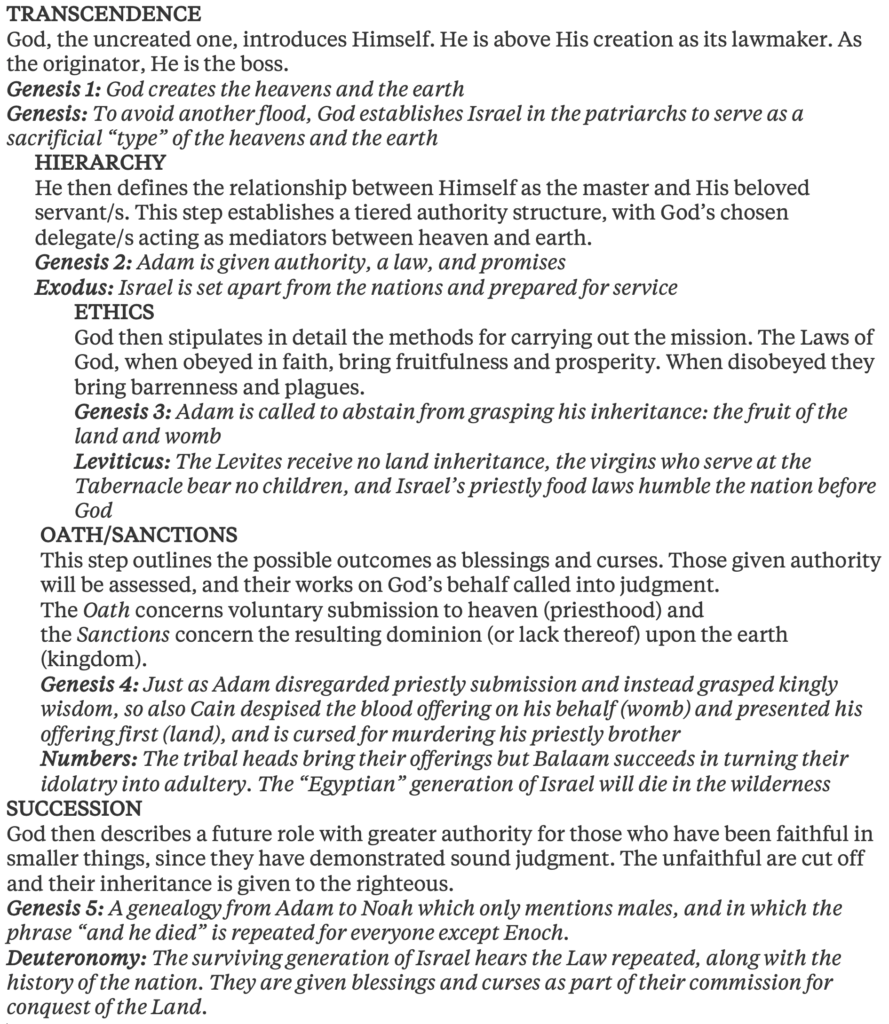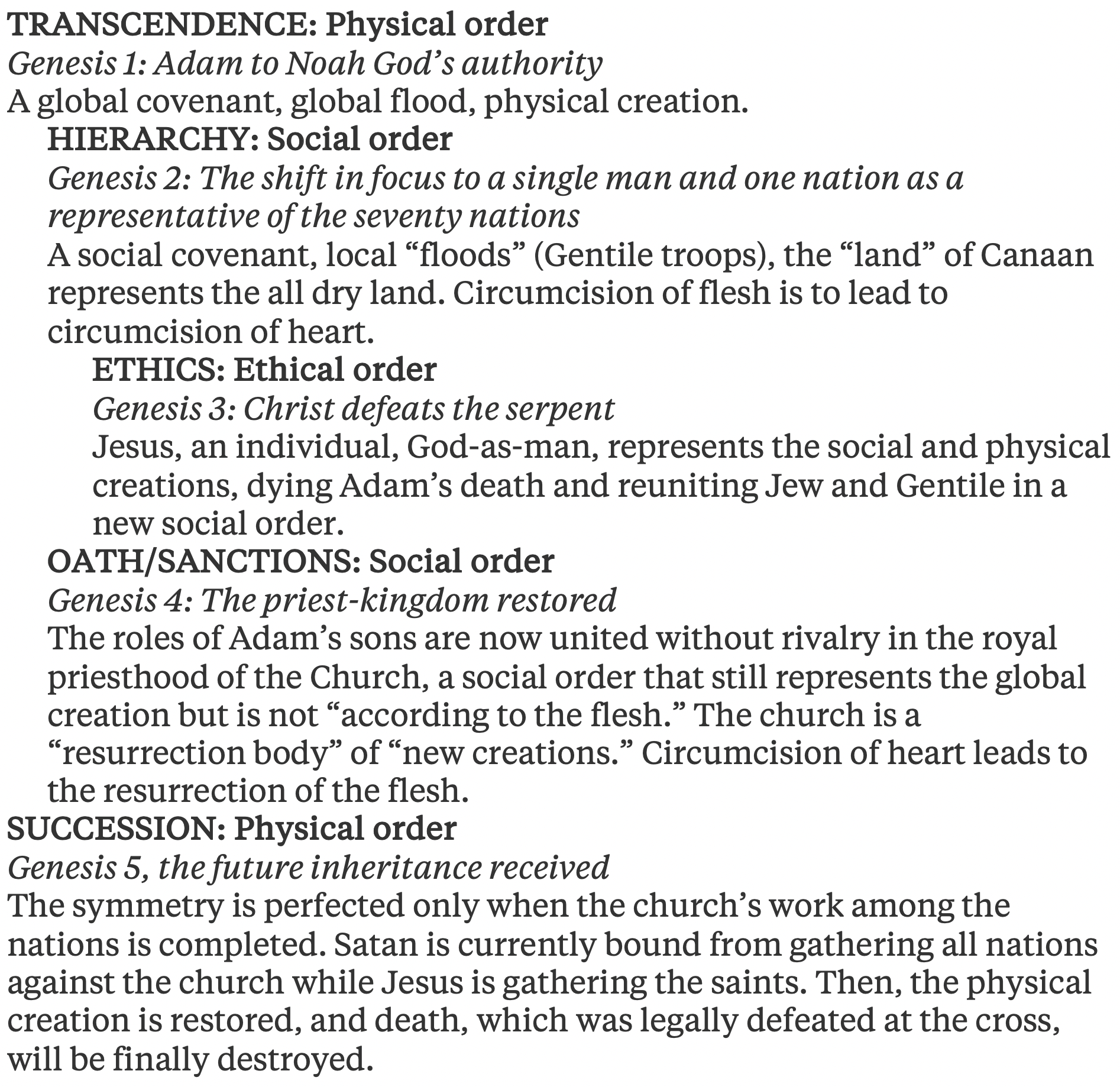“Covenant Creationism,” which might be the most consistent brand of full preterism, is merely dispensationalism turned inside-out.
The main cause of disputes over the interpretation of the Scriptures is the practice of interpreting texts in isolation. This applies not only to interpreting a passage without reference to other passages, but also to using proof texts which have been isolated from their covenantal framework. In many cases, the dispute is a false dichotomy. Each side of the debate is both right and wrong, just in opposite places. The real problem is the failure to figure out how to put the pieces of the puzzle together.
Dispensationalists are generally also Young Earth Creationists. This is why they take the “cosmic language” of the New Testament literally. They are trying to be consistent. The problem is that this requires them to ignore the “time indicators” in the text. Events that were “near” and supposed to happen “shortly” have to be pushed from the first century into the far future—possibly into our own day.
The self-described “Covenant Creationists” rightly understand that the language in the New Testament is pictorial, speaking of covenantal events which were imminent. Global language was indeed used to describe local events, but they fail to ask why. Wrongly assuming that this is somehow the norm, a sort of “hermeneutical uniformitarianism” akin to that of the dispensationalists but in the other direction, they understandably use this global=local rubric to limit the scope of the events in Genesis 1-9.
They insist that the Creation Week was not an act of creation by God, but merely an act of giving pre-existing things a new purpose. They claim that Adam was simply being selected from among other people for a covenantal role in the way that Abraham was. This makes nonsense of the details given to us in Genesis 1, 2, and 3, and requires a redefinition of the death about which Adam was warned. This steamrolling of the features of the text to fit a “blanket” agenda is considered good practice because it has the appearance of hermeneutical consistency.

Since Daniel and Jesus said that the destruction of Jerusalem would be like a flood (Daniel 9:26; Matthew 24:36-39), and since that first-century judgment was a local event and not a global one, they assert that the “Great Flood” was also merely a local event. The phrase “all flesh” is used of local judgments, so why could this limitation not apply to the actual flood itself? Is that not being consistent?
The answer to the question is actually fairly simple, and the key is the five-point architecture of biblical covenants. This structure, in a handful of variations, governed the composition of all Scripture and all biblical history. It is found in the first five chapters of Genesis and also in the basic themes of the five books of Moses, the Pentateuch.
The pattern of covenant is not only a “tour of duty,” but also a process of transformation. The “testing” at the center is a refining by fire. For Adam, this refinement (Ethics) resulted in a failure to obey in faith, a false testimony to God in which he blamed God and the Woman (Oath) and the necessity of a blood atonement to mitigate the full force of the curses (Sanctions). Adam’s future was preserved but not without consequences. We see the same thing in David, who, although he repented and confessed his sins (Oath), lost the child of his sin with Bathsheba and was told by God that the sword would never depart from his house (Sanctions). If we have eyes to see, we can observe that this “mission from God” pattern structures all Scripture, and all biblical history. There is an ultimate authority at the beginning and a new beginning at the end.
However, you will notice that the second step (Hierarchy) and the second-last step (Oath/Sanctions) concern the man or men to whom that authority was delegated. Hierarchy is the delegation of the authority and Oath/Sanctions is the reckoning, the judgment of the delegate’s faithfulness with that authority.
God always works through mediators. He does this because God the Father works through God the Son by God the Spirit. Once we get a grip on the difference between the Transcendent authority of God and that authority as it is represented in Man, we can also get a grip on the flaw in the supposedly-consistent methodologies of dispensationalism and full preterism. The problem becomes obvious when we observe how this same chiastic (symmetrical) pattern structures all of biblical history.

This “Word – Land – Garden – Land – World” pattern was recapitulated in the liturgical journey of the High Priest on the Day of Atonement. He would move from the Court of Sacrifice into the Holy Place and finally the Most Holy Place. Then he would journey out again. The entire book of Leviticus is also structured after this sequence of domains.
What we must understand is that like the Garden, the Land, and the World, the steps in this fivefold process of transformation are linked but distinct. Each informs the other, but conflating them is a grave error with serious doctrinal consequences. The stepped process has to do with legal representation. The dispensationalist who thinks that Jerusalem’s Temple has to be restored before the final judgment has misunderstood the role of Israel as a legal representative of the nations, a role that has now ended.
Full preterism is even worse. It cuts both ends off the sequence, unmooring covenant history from the beginning and end of the physical world. It is merely “social” and not “creational.” With no true beginning or end, history has no reckoning and becomes a rut—and a rut is simply a grave with the ends kicked out. The willingness of full preterism to teach that death had no beginning, was not introduced by the sin of Man in the Garden, and as no actual end, is reprehensible. It also puts full preterism outside of Orthodox Christianity.
To clarify, the dispensationalist interprets the microcosmic language of the social order as if it referred to the physical order, and the full preterist interprets the macrocosmic language of the physical order as if it referred to the social order. In each case, the error is understandable, but has serious consequences for the interpretation of Scripture. God works in cycles and layers, so we must stop thinking in two dimensions and start working according to the three-dimensional architecture that He has given us in His Word.
Correcting the mistake of the dispensationalist gives the Bible back to us as the true heirs of Abraham, and enables us to interpret the New Testament in the way that it was intended—as a legal witness against the first-century rulers. Correcting the mistake of the Covenant Creationist shafts Darwinism’s death cult, abolishes a neognostic redefinition of death and resurrection, and also explains why it was those inside the ark of Noah who were saved but those inside of Jerusalem who were destroyed. The conflation of the two is an error of titanic proportions. Full preterism’s consequences are much worse than those of dispensationalism. It is a doctrine that must be rejected. I hope this brief essay is a helpful tool for saints of all schools and traditions.
Michael Bull is a graphic designer in the Blue Mountains west of Sydney in Australia, and author, most recently, of Schema, A Journal of Systematic Typology, Vol. 5. He blogs at Bible Matrix.
